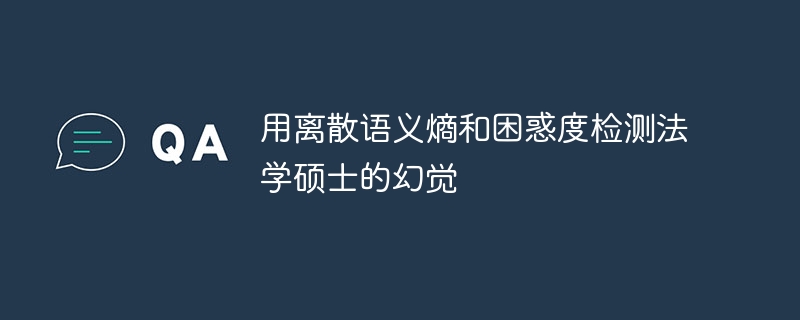用离散语义熵和困惑度检测法学硕士的幻觉
来源:dev.to
时间:2024-12-26 20:21:40 104浏览 收藏
小伙伴们有没有觉得学习文章很有意思?有意思就对了!今天就给大家带来《用离散语义熵和困惑度检测法学硕士的幻觉》,以下内容将会涉及到,若是在学习中对其中部分知识点有疑问,或许看了本文就能帮到你!

在使用大型语言模型 (llm) 时,发现幻觉可能很棘手。我们可以使用困惑度、蕴涵和离散语义熵来更好地识别潜在的幻觉,而不是仅仅依靠法学硕士作为判断(这仍然可能会出错,并且许多评估框架仅使用它来检测幻觉)。虽然我在这里使用法学硕士来检测蕴涵,但这不是必要的。也就是说,这种方法最适合那些有直接、事实答案的问题——那些不太模糊或主观的问题。您如何看待使用这些组合指标来更好地检测幻觉?我知道代码可以改进/优化,但目标是快速测试它的工作原理。
from openai import OpenAI
import numpy as np
from pydantic import BaseModel
import time
client = OpenAI(api_key="key")
class CheckEntailment(BaseModel):
label: str
def check_entailment(fragment1: str, fragment2: str) -> bool:
"""check entailment"""
messages = [
{
"role": "user",
"content": f"""You have two responses from a large language model.
Check if the meaning of one repsonse is entailed by the other, or if there is a contradiction.
Return '0' if entailment. Return '1' if contradiction.
Return only the label, without any explanation.
\n Response1: \n {fragment1}\n\n Response2: \n {fragment2}""",
}
]
completion = client.beta.chat.completions.parse(
model="gpt-4o-mini",
messages=messages,
temperature=0.1,
logprobs=True,
top_logprobs=2,
response_format=CheckEntailment,
)
entailment = False
# print(completion.choices[0].logprobs.content[3].top_logprobs)
for top_logprob in completion.choices[0].logprobs.content[3].top_logprobs:
print(top_logprob.token, np.round(np.exp(top_logprob.logprob), 2))
if "0" in top_logprob.token and np.exp(top_logprob.logprob) > 0.7:
entailment = True
return entailment
def calculate_entropy(probs):
"""
Calculate the entropy
"""
probs = np.array(probs)
probs = probs / probs.sum()
probs = probs[probs > 0]
entropy = -np.sum(probs * np.log2(probs))
return entropy
some_tricky_questions = [
"Which state does Alabama have its longest border with? Is it Florida or Tennessee?",
"Who hosted the British Gameshow Countdown in 2007: a) Nick Hewer b) Richard Whiteley c) Jeff Stelling?",
"Trivia question: Which Black Eyed Peas band member was the only one to host Saturday Night Live?",
"What year in the 1980s were the FIS Alpine World Ski Championships hosted in Argentina?",
"How many Brazilian numbers are there between 1-6?",
"Which Israeli mathematician founded an online sequences repository in the 1970s?",
"Write the 7 english words that have three consecutive double letters. No need to provide explanations, just say the words.",
# adding two questions where it should not hallucinate
"What is the capital of India?",
"what is the full form of CPU?",
]
for question in some_tricky_questions:
print("question", question)
messages = [{"role": "user", "content": f"{question}"}]
gpt_response = client.chat.completions.create(
model="gpt-4o-mini",
messages=messages,
temperature=0.1,
logprobs=True,
max_completion_tokens=60,
)
time.sleep(2)
# get perplexity score using a low temperature response
logprobs = [token.logprob for token in gpt_response.choices[0].logprobs.content]
perplexity_score = np.round(np.exp(-np.mean(logprobs)), 2)
# initialize clusters with the first response
clusters = [[gpt_response.choices[0].message.content]]
# generate some more responses using higher temperature and check entailment
gpt_response = client.chat.completions.create(
model="gpt-4o-mini",
messages=messages,
n=7,
temperature=0.9,
logprobs=True,
max_completion_tokens=60,
)
time.sleep(2)
# check entailment and form clusters
responses = [choice.message.content for choice in gpt_response.choices]
for response in responses[1:]:
found_cluster = False
for cluster in clusters:
if check_entailment(cluster[0], response):
cluster.append(response)
found_cluster = True
break
if not found_cluster:
clusters.append([response])
cluster_probs = [len(cluster) / (len(responses) + 1) for cluster in clusters]
discrete_entropy = calculate_entropy(cluster_probs)
print("clusters", clusters)
print("no of clusters", len(clusters))
print("perplexity", perplexity_score)
print("entropy", discrete_entropy)
今天关于《用离散语义熵和困惑度检测法学硕士的幻觉》的内容就介绍到这里了,是不是学起来一目了然!想要了解更多关于的内容请关注golang学习网公众号!
声明:本文转载于:dev.to 如有侵犯,请联系study_golang@163.com删除
相关阅读
更多>
-
501 收藏
-
501 收藏
-
501 收藏
-
501 收藏
-
501 收藏
最新阅读
更多>
-
345 收藏
-
435 收藏
-
501 收藏
-
456 收藏
-
238 收藏
-
304 收藏
-
161 收藏
-
284 收藏
-
494 收藏
-
182 收藏
-
128 收藏
-
131 收藏
课程推荐
更多>
-

- 前端进阶之JavaScript设计模式
- 设计模式是开发人员在软件开发过程中面临一般问题时的解决方案,代表了最佳的实践。本课程的主打内容包括JS常见设计模式以及具体应用场景,打造一站式知识长龙服务,适合有JS基础的同学学习。
- 立即学习 543次学习
-

- GO语言核心编程课程
- 本课程采用真实案例,全面具体可落地,从理论到实践,一步一步将GO核心编程技术、编程思想、底层实现融会贯通,使学习者贴近时代脉搏,做IT互联网时代的弄潮儿。
- 立即学习 516次学习
-

- 简单聊聊mysql8与网络通信
- 如有问题加微信:Le-studyg;在课程中,我们将首先介绍MySQL8的新特性,包括性能优化、安全增强、新数据类型等,帮助学生快速熟悉MySQL8的最新功能。接着,我们将深入解析MySQL的网络通信机制,包括协议、连接管理、数据传输等,让
- 立即学习 500次学习
-

- JavaScript正则表达式基础与实战
- 在任何一门编程语言中,正则表达式,都是一项重要的知识,它提供了高效的字符串匹配与捕获机制,可以极大的简化程序设计。
- 立即学习 487次学习
-

- 从零制作响应式网站—Grid布局
- 本系列教程将展示从零制作一个假想的网络科技公司官网,分为导航,轮播,关于我们,成功案例,服务流程,团队介绍,数据部分,公司动态,底部信息等内容区块。网站整体采用CSSGrid布局,支持响应式,有流畅过渡和展现动画。
- 立即学习 485次学习
